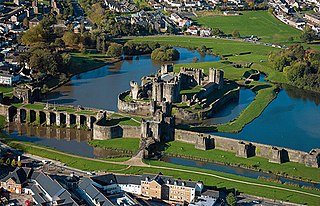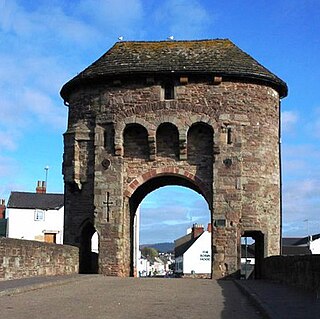 W
WBangor Cathedral is an ancient place of worship in Bangor, Gwynedd, Wales. It is dedicated to its founder, Saint Deiniol.
 W
WCaerphilly Castle is a medieval fortification in Caerphilly in South Wales. The castle was constructed by Gilbert de Clare in the 13th century as part of his campaign to maintain control of Glamorgan, and saw extensive fighting between Gilbert, his descendants, and the native Welsh rulers. Surrounded by extensive artificial lakes – considered by historian Allen Brown to be "the most elaborate water defences in all Britain" – it occupies around 30 acres (12 ha) and is the second largest castle in the United Kingdom. It is famous for having introduced concentric castle defences to Britain and for its large gatehouses. Gilbert began work on the castle in 1268 following his occupation of the north of Glamorgan, with the majority of the construction occurring over the next three years at a considerable cost. The project was opposed by Gilbert's Welsh rival Llywelyn ap Gruffudd, leading to the site being burnt in 1270 and taken over by royal officials in 1271. Despite these interruptions, Gilbert successfully completed the castle and took control of the region. The core of Caerphilly Castle, including the castle's luxurious accommodation, was built on what became a central island, surrounding by several artificial lakes, a design Gilbert probably derived from that at Kenilworth. The dams for these lakes were further fortified, and an island to the west provided additional protection. The concentric rings of walls inspired Edward I's castles in North Wales, and proved what historian Norman Pounds has termed "a turning point in the history of the castle in Britain".
 W
WThis is a list of castles in Wales, sometimes called the "castle capital of the world" because of the large number of castles in a relatively small area. Wales had about 600 castles, of which over 100 are still standing, either as ruins or as restored buildings. The rest have returned to nature, and today consist of ditches, mounds, and earthworks, often in commanding positions. Many of the sites in Wales are cared for by Cadw, the Welsh government's historic environment service.
 W
WThe Monmouth town walls and defences comprise the defensive system of town walls and gates built in Monmouth, Wales between 1297 and the early part of the following century. Wye Bridge Gate, East Gate, Monk's Gate, and Monnow Bridge Gate were access points to the town. West Gate, across Monnow Street, also provided access. Only the Monnow Bridge Gatehouse survives intact, albeit in a substantially modified version from the original.
 W
WNewcastle Castle is a medieval castle located on Newcastle Hill, Newcastle, overlooking the town centre of Bridgend in Glamorgan, South Wales. It was originally believed to date from 1106 when a ringwork was created at the site by the Norman baron Robert Fitzhamon. Some of the fine stonework survives, but today the castle is ruinous.
 W
WPainscastle Castle is a castle in the village of Painscastle in Powys, Wales. It lies between Builth and Hay-on-Wye, approximately 3 miles from the Wales-England border today.
 W
WSt Grwst's Church, Llanrwst, is located in Church Street, Llanrwst, Conwy, Wales. It is an active Church in Wales parish church in the deanery of Llanrwst and Rhos, the archdeaconry of St Asaph, and the diocese of St Asaph. Its benefice is united with those of Llanddoged with Capel Garmon, Llansanffraid Glan Conwy, and Eglwysbach. The church is designated by Cadw as a Grade I listed building.
 W
WThe Parish Church of St Michael's & All Angels is a Grade II* listed parish church in Llantarnam, near Cwmbran, Torfaen, Wales.